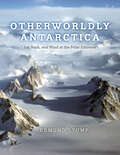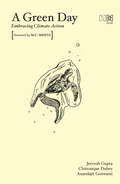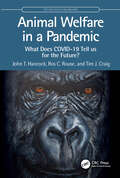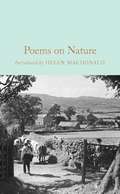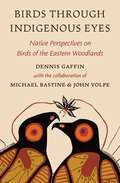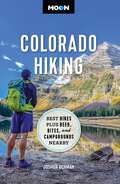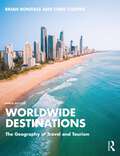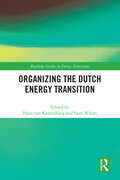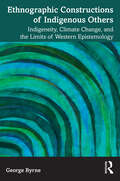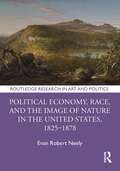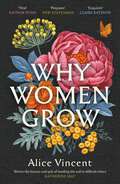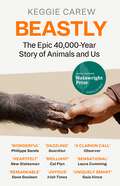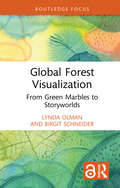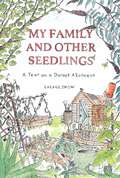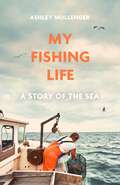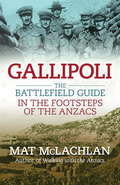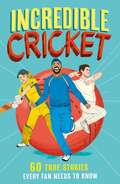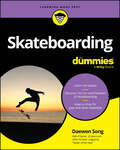- Table View
- List View
Otherworldly Antarctica: Ice, Rock, and Wind at the Polar Extreme
by Edmund StumpWith stunning original photographs, an Antarctic scientist and explorer takes us to one of the most sublime, remote, and pristine regions on the planet. The interior of Antarctica is an utterly pristine wilderness, a desolate landscape of ice, wind, and rock; a landscape so unfamiliar as to seem of another world. This place has been known to only a handful of early explorers and the few scientists fortunate enough to have worked there. Edmund Stump is one of the lucky few. Having climbed, photographed, and studied more of the continent-spanning Transantarctic Mountains than any other person on Earth, this geologist, writer, and photographer is uniquely suited to share these alien sights. With stories of Stump’s forty years of journeys and science, Otherworldly Antarctica contains 130 original color photographs, complemented by watercolors and sketches by artist Marlene Hill Donnelly. Over three chapters—on the ice, the rock, and the wind—we meet snowy paths first followed during Antarctica’s Heroic Age, climb the central spire of the Organ Pipe Peaks, peer into the crater of the volcanic Mount Erebus, and traverse Liv Glacier on snowmobile, while avoiding fatal falls into the blue interiors of hidden crevasses. Along the way, we see the beauty of granite, marble, and ice-cored moraines, meltwater ponds, lenticular clouds, icebergs, and glaciers. Many of Stump’s breathtaking images are aerial shots taken from the planes and helicopters that brought him to the interior. More were shot from vantages gained by climbing the mountains he studied. Some were taken from the summits of peaks. Many are of places no one had set foot before—or has since. All seem both permanent and precarious, connecting this otherworld to our fragile own.
Otherworldly Antarctica: Ice, Rock, and Wind at the Polar Extreme
by Edmund StumpWith stunning original photographs, an Antarctic scientist and explorer takes us to one of the most sublime, remote, and pristine regions on the planet. The interior of Antarctica is an utterly pristine wilderness, a desolate landscape of ice, wind, and rock; a landscape so unfamiliar as to seem of another world. This place has been known to only a handful of early explorers and the few scientists fortunate enough to have worked there. Edmund Stump is one of the lucky few. Having climbed, photographed, and studied more of the continent-spanning Transantarctic Mountains than any other person on Earth, this geologist, writer, and photographer is uniquely suited to share these alien sights. With stories of Stump’s forty years of journeys and science, Otherworldly Antarctica contains 130 original color photographs, complemented by watercolors and sketches by artist Marlene Hill Donnelly. Over three chapters—on the ice, the rock, and the wind—we meet snowy paths first followed during Antarctica’s Heroic Age, climb the central spire of the Organ Pipe Peaks, peer into the crater of the volcanic Mount Erebus, and traverse Liv Glacier on snowmobile, while avoiding fatal falls into the blue interiors of hidden crevasses. Along the way, we see the beauty of granite, marble, and ice-cored moraines, meltwater ponds, lenticular clouds, icebergs, and glaciers. Many of Stump’s breathtaking images are aerial shots taken from the planes and helicopters that brought him to the interior. More were shot from vantages gained by climbing the mountains he studied. Some were taken from the summits of peaks. Many are of places no one had set foot before—or has since. All seem both permanent and precarious, connecting this otherworld to our fragile own.
A Green Day: Embracing Climate Action
by Jeevesh Gupta Chittranjan Dubey Anandajit GoswamiAn Engaging Compilation of Perspectives on Climate Activism The impassioned essays, noteworthy profiles and first-person narratives in this anthology champion grassroots and global environmental movements that have persuaded policymakers and mobilized communities to take note of the worsening state of the natural order. From the Global South to the Global North, change advocates and those experiencing the thick of the emergency revisit the tipping points in their activism journey, lay out harsh truths about the extent of damage caused and offer scalable solutions to combat the mounting crisis. Outlining their rage, despair, fears and hope for the future, the campaigners underscore that there may be reasons to be optimistic despite the dreary reality we find ourselves in. While calling for collective action, these wide-ranging, inspiring and urgent stories reflect a diverse landscape of climate activism and are enough evidence that a sea change is possible.
Animal Welfare in a Pandemic: What Does COVID-19 Tell us for the Future? (CRC One Health One Welfare)
by John T. Hancock Ros C. Rouse Tim J. CraigAnimal Welfare in a Pandemic explores the impact of COVID-19 on a wide array of animals, from those in the wild to companion and captive animals. During the height of the pandemic, a range of animals were infected, and many died, but this was hard to predict, even using up-to-date bioinformatics. Lockdowns around the world had, and continue to have, a major effect on animals’ welfare, influencing pet ownership and care, as well as impacting on the work of conservation institutes due to the lack of visitors and funding and lack of tourist presence in the wild which impacted on anti-poaching efforts. Some of the vast amount of personal protection equipment (PPE) that was distributed was discarded, creating both dangers and occasional opportunities for wild animals. With the rollout of human vaccines, some countries started developing animal vaccines, only some of which were deployed. In summary, the pandemic had a wide-ranging influence on animal welfare around the world. This is reviewed to highlight what can be learned to protect and enhance animal welfare in future epidemics/pandemics, and contribute to a genuinely One Health approach where the health and welfare of both humans and animals are considered holistically.This book is authored by members of the University of the West of England, Bristol, who span a range of expertise in Biological Sciences, Social Sciences, Animal Welfare, and Ethics.
Animal Welfare in a Pandemic: What Does COVID-19 Tell us for the Future? (CRC One Health One Welfare)
by John T. Hancock Ros C. Rouse Tim J. CraigAnimal Welfare in a Pandemic explores the impact of COVID-19 on a wide array of animals, from those in the wild to companion and captive animals. During the height of the pandemic, a range of animals were infected, and many died, but this was hard to predict, even using up-to-date bioinformatics. Lockdowns around the world had, and continue to have, a major effect on animals’ welfare, influencing pet ownership and care, as well as impacting on the work of conservation institutes due to the lack of visitors and funding and lack of tourist presence in the wild which impacted on anti-poaching efforts. Some of the vast amount of personal protection equipment (PPE) that was distributed was discarded, creating both dangers and occasional opportunities for wild animals. With the rollout of human vaccines, some countries started developing animal vaccines, only some of which were deployed. In summary, the pandemic had a wide-ranging influence on animal welfare around the world. This is reviewed to highlight what can be learned to protect and enhance animal welfare in future epidemics/pandemics, and contribute to a genuinely One Health approach where the health and welfare of both humans and animals are considered holistically.This book is authored by members of the University of the West of England, Bristol, who span a range of expertise in Biological Sciences, Social Sciences, Animal Welfare, and Ethics.
Poems on Nature (Macmillan Collector's Library #229)
by Gaby MorganThe poems in Poems on Nature are divided into spring, summer, autumn and winter to reflect in verse the changes of the seasons and the passing of time.Part of the Macmillan Collectors Library series, featuring expert introductions for your favourite classics. This edition features an introduction by Helen Macdonald, author of the international bestseller, H is for Hawk.Since poetry began, there have been poems about nature; it’s a complex subject which has inspired some of the most beautiful poetry ever written. Poets from Andrew Marvell to W. B. Yeats to Emily Brontë have sought to describe the natural environment and our relationship with it. There is also a rich tradition of songs and rhymes, such as ’Scarborough Fair’, that hark back to a rural way of life which may now be lost, but is brought back to life in the lyrical verses included in this collection.
Birds through Indigenous Eyes: Native Perspectives on Birds of the Eastern Woodlands
by Dennis GaffinAn intimate and personal account of the profound roles birds play in the lives of some Indigenous peopleFor many hours over a period of years, white anthropologist Dennis Gaffin and two Indigenous friends, Michael Bastine and John Volpe, recorded their conversations about a shared passion: the birds of upstate New York and southern Ontario. In these lively, informal talks, Bastine (a healer and naturalist of Algonquin descent) and Volpe (a naturalist and animal rehabilitator of Ojibwe and Métis descent) shared their experiences of, and beliefs about, birds, describing the profound spiritual, psychological, and social roles of birds in the lives of some Indigenous people. Birds through Indigenous Eyes presents highlights of these conversations, placing them in context and showing how Native understandings of birds contrast with conventional Western views.Bastine and Volpe bring to life Algonquin, Ojibwe, and Haudenosaunee (Iroquois) beliefs about birds. They reveal how specific birds and bird species are seamlessly integrated into spirituality and everyday thought and action, how birds bring important messages to individual people, how a bird species can become associated with a person, and how birds provide warnings about our endangered environment. Over the course of the book, birds such as the house sparrow, Eastern phoebe, Northern flicker, belted kingfisher, gray catbird, cedar waxwing, and black-capped chickadee are shown in a new light—as spiritual and practical helpers that can teach humans how to live well.An original work of ethno-ornithology that offers a rare close-up look at some Native views on birds, Birds through Indigenous Eyes opens rich new perspectives on the deep connections between birds and humans.
Birds through Indigenous Eyes: Native Perspectives on Birds of the Eastern Woodlands
by Dennis GaffinAn intimate and personal account of the profound roles birds play in the lives of some Indigenous peopleFor many hours over a period of years, white anthropologist Dennis Gaffin and two Indigenous friends, Michael Bastine and John Volpe, recorded their conversations about a shared passion: the birds of upstate New York and southern Ontario. In these lively, informal talks, Bastine (a healer and naturalist of Algonquin descent) and Volpe (a naturalist and animal rehabilitator of Ojibwe and Métis descent) shared their experiences of, and beliefs about, birds, describing the profound spiritual, psychological, and social roles of birds in the lives of some Indigenous people. Birds through Indigenous Eyes presents highlights of these conversations, placing them in context and showing how Native understandings of birds contrast with conventional Western views.Bastine and Volpe bring to life Algonquin, Ojibwe, and Haudenosaunee (Iroquois) beliefs about birds. They reveal how specific birds and bird species are seamlessly integrated into spirituality and everyday thought and action, how birds bring important messages to individual people, how a bird species can become associated with a person, and how birds provide warnings about our endangered environment. Over the course of the book, birds such as the house sparrow, Eastern phoebe, Northern flicker, belted kingfisher, gray catbird, cedar waxwing, and black-capped chickadee are shown in a new light—as spiritual and practical helpers that can teach humans how to live well.An original work of ethno-ornithology that offers a rare close-up look at some Native views on birds, Birds through Indigenous Eyes opens rich new perspectives on the deep connections between birds and humans.
Moon Colorado Hiking: Best Hikes Plus Beer, Bites, and Campgrounds Nearby (Travel Guide)
by Joshua Berman Moon Travel GuidesColorado is a hiker&’s paradise. With four national parks and a dozen national monuments, recreation areas and more, adventure is at every turn. Pack a lunch, lace up your boots, and hit the trails with Moon Colorado Hiking. Inside you'll find:Diverse Hiking Options: Whether you plan to hike to the crest of the Continental Divide, through thick fairytale aspen groves or to one of hundreds of iconic snow-capped peaks, enjoy outdoor getaways ranging from easy day hikes to multi-day backpacking trips Find Your Hike: Looking for something specific? Choose from strategic lists of the best hikes for wildflowers, waterfalls, or hiking with your dog, plus a breakdown of the best hikes by season The Top Outdoor Experiences: Climb the dunes at Great Sand Dunes National Park and Preserve or walk through golden aspen groves along Kenosha Pass. Gawk at red rock formations along the Garden of the Gods Loop or challenge yourself while you huff and puff to the top of Quandary Peak Nearby Fun: Spend a night under the stars at a nearby campground or sip a refreshing local brew after a day on the trail Essential Planning Details: Each hike is described in detail and marked with round-trip distance and hiking time, difficulty, terrain type, elevation gain, and access points Maps and Directions: Find easy-to-use maps, driving directions to each trailhead, and details on where to park Expert Advice: Seasoned hiker Joshua Berman offers experienced insights, local secrets, and honest opinions of each trail Tips and Tools: Advice on gear, first aid, and camping permits, plus background information on climate, landscape, and wildlife Whether you're a veteran or a first-time hiker, Moon's comprehensive coverage and local expertise will have you gearing up for your next adventure.About Moon Travel Guides: Moon was founded in 1973 to empower independent, active, and conscious travel. We prioritize local businesses, outdoor recreation, and traveling strategically and sustainably. Moon Travel Guides are written by local, expert authors with great stories to tell—and they can't wait to share their favorite places with you. Pitching a tent? Check out Moon Colorado Camping!
Worldwide Destinations: The Geography of Travel and Tourism
by Brian Boniface Chris CooperWorldwide Destinations: The Geography of Travel and Tourism is a unique text that explores tourism demand, supply, organisation, and resources for every country worldwide in a logically structured and accessible format.The ninth edition is fully updated to include the following features: Greater exploration of current issues such as climate change, the impact of COVID-19 on destinations and subsequent recovery strategies, regenerative tourism, changes in consumer behaviour, and sustainability New and updated case studies throughout Increased emphasis on South America and a new chapter focussing on the tourism geography of Antarctica Enhanced online resources for lecturers and students including PPTs, web links, video links, MCQs, and discussion questions The first part of this book comprises thematic chapters that detail the geographic knowledge and principles required to analyse the tourism appeal of destinations. The subsequent division of this book into regional chapters enables the student to carry out a systematic analysis of a particular destination by providing insights on cultural characteristics as well as information on specific places.This volume is an invaluable resource for studying every destination in the world, explaining tourism demand, evaluating the many types of tourist attractions, and examining the trends that may shape the future geography of tourism. This thorough guide is a must-have for any student undertaking a course in travel and tourism.
Worldwide Destinations: The Geography of Travel and Tourism
by Brian Boniface Chris CooperWorldwide Destinations: The Geography of Travel and Tourism is a unique text that explores tourism demand, supply, organisation, and resources for every country worldwide in a logically structured and accessible format.The ninth edition is fully updated to include the following features: Greater exploration of current issues such as climate change, the impact of COVID-19 on destinations and subsequent recovery strategies, regenerative tourism, changes in consumer behaviour, and sustainability New and updated case studies throughout Increased emphasis on South America and a new chapter focussing on the tourism geography of Antarctica Enhanced online resources for lecturers and students including PPTs, web links, video links, MCQs, and discussion questions The first part of this book comprises thematic chapters that detail the geographic knowledge and principles required to analyse the tourism appeal of destinations. The subsequent division of this book into regional chapters enables the student to carry out a systematic analysis of a particular destination by providing insights on cultural characteristics as well as information on specific places.This volume is an invaluable resource for studying every destination in the world, explaining tourism demand, evaluating the many types of tourist attractions, and examining the trends that may shape the future geography of tourism. This thorough guide is a must-have for any student undertaking a course in travel and tourism.
Organizing the Dutch Energy Transition (Routledge Studies in Energy Transitions)
This book addresses learnings from the energy transition in the Netherlands.This book brings together contributions from experts in academia and practice to the Dutch energy transition by sharing their knowledge and experience gained over many years and from different roles and responsibilities. The chapters are clustered around four key perspectives – Policy, Sector, Organization, and Future – and explore the impact of policy decisions of governments and strategic decisions of firms operating in the energy sector on the energy transition process. The different perspectives present many promising strategies, policies, and innovations on each aspect, resulting in a deeper understanding of how each of these strategies, policies, and innovations may hinder or contribute to foster the energy transition. It concludes with a reflection on lessons learned and specific managerial and policy recommendations.This volume will be of great interest to students, scholars, and industry professionals researching and working in the areas of energy transitions, sustainable business, energy technology, and energy policy.
Organizing the Dutch Energy Transition (Routledge Studies in Energy Transitions)
by Hans Van Kranenburg Sjors WitjesThis book addresses learnings from the energy transition in the Netherlands.This book brings together contributions from experts in academia and practice to the Dutch energy transition by sharing their knowledge and experience gained over many years and from different roles and responsibilities. The chapters are clustered around four key perspectives – Policy, Sector, Organization, and Future – and explore the impact of policy decisions of governments and strategic decisions of firms operating in the energy sector on the energy transition process. The different perspectives present many promising strategies, policies, and innovations on each aspect, resulting in a deeper understanding of how each of these strategies, policies, and innovations may hinder or contribute to foster the energy transition. It concludes with a reflection on lessons learned and specific managerial and policy recommendations.This volume will be of great interest to students, scholars, and industry professionals researching and working in the areas of energy transitions, sustainable business, energy technology, and energy policy.
Ethnographic Constructions of Indigenous Others: Indigeneity, Climate Change, and the Limits of Western Epistemology
by George ByrneThis book examines the ways in which indigeneity interacts with climate change politics at multiple levels and at the same time offers a self-critical reflection on the role of ethnographic research (and researchers) in this process. Through a multi-sited ethnography, it shows how indigeneity and climate change mitigation are at this point so intensely intertwined that one cannot be clearly understood without considering the other. While indigenous identities have been (re)defined in relation to climate change, it argues that Indigenous Peoples continue to subvert pervasive notions of the nature/culture dichotomy and disrupt our understanding of what it means to be human in relation to nature. It encourages students and researchers in anthropology, international development, and other related fields to engage in more meaningful reflection on the epistemic shortcomings of “the West”, including in our own research, and to acknowledge the ongoing role of power, coloniality, extractivism, and whiteness in climate change discourses.
Ethnographic Constructions of Indigenous Others: Indigeneity, Climate Change, and the Limits of Western Epistemology
by George ByrneThis book examines the ways in which indigeneity interacts with climate change politics at multiple levels and at the same time offers a self-critical reflection on the role of ethnographic research (and researchers) in this process. Through a multi-sited ethnography, it shows how indigeneity and climate change mitigation are at this point so intensely intertwined that one cannot be clearly understood without considering the other. While indigenous identities have been (re)defined in relation to climate change, it argues that Indigenous Peoples continue to subvert pervasive notions of the nature/culture dichotomy and disrupt our understanding of what it means to be human in relation to nature. It encourages students and researchers in anthropology, international development, and other related fields to engage in more meaningful reflection on the epistemic shortcomings of “the West”, including in our own research, and to acknowledge the ongoing role of power, coloniality, extractivism, and whiteness in climate change discourses.
Political Economy, Race, and the Image of Nature in the United States, 1825–1878 (Routledge Research in Art and Politics)
by Evan Robert NeelyPolitical Economy, Race, and the Image of Nature in the United States, 1825–1878 is an interdisciplinary work analyzing the historical origins of a dominant concept of Nature in the culture of the United States during the period of its expansion across the continent.Chapters analyze the ways in which “Nature” became a discursive site where theories of race and belonging, adaptation and environment, and the uses of literary and pictorial representation were being renegotiated, forming the basis for an ideal of the human and the nonhuman world that is still with us. Through an interdisciplinary approach involving the fields of visual culture, political economy, histories of racial identity, and ecocritical studies, the book examines the work of seminal figures in a variety of literary and artistic disciplines and puts the visual culture of the United States at the center of intellectual trends that have enormous implications for contemporary cultural practice.The book will be of interest to scholars working in art history, visual culture, American studies, environmental studies/ecocriticism, critical race theory, and semiotics.
Political Economy, Race, and the Image of Nature in the United States, 1825–1878 (Routledge Research in Art and Politics)
by Evan Robert NeelyPolitical Economy, Race, and the Image of Nature in the United States, 1825–1878 is an interdisciplinary work analyzing the historical origins of a dominant concept of Nature in the culture of the United States during the period of its expansion across the continent.Chapters analyze the ways in which “Nature” became a discursive site where theories of race and belonging, adaptation and environment, and the uses of literary and pictorial representation were being renegotiated, forming the basis for an ideal of the human and the nonhuman world that is still with us. Through an interdisciplinary approach involving the fields of visual culture, political economy, histories of racial identity, and ecocritical studies, the book examines the work of seminal figures in a variety of literary and artistic disciplines and puts the visual culture of the United States at the center of intellectual trends that have enormous implications for contemporary cultural practice.The book will be of interest to scholars working in art history, visual culture, American studies, environmental studies/ecocriticism, critical race theory, and semiotics.
Why Women Grow: Stories of Soil, Sisterhood and Survival
by Alice VincentLONGLISTED FOR THE WAINWRIGHT PRIZE FOR NATURE WRITING SHORTLISTED FOR THE BOOKS ARE MY BAG READERS AWARD FOR NON-FICTION THE TIMES / WATERSTONES TOP 10 BESTSELLER A BOOK OF THE YEAR FOR THE INDEPENDENT, STYLIST, RHS, GARDENS ILLUSTRATED and more Women have always gardened, but our stories have been buried with our work. Alice Vincent is on a quest to change that: to understand what encourages women to go out, work the soil, plant seeds and nurture them, even when so many other responsibilities sit upon their shoulders. To recover the histories that have been lost among the soil and to understand women’s lives, their gardens and what the ground has offered them. Wise, curious and sensitive, Why Women Grow follows Alice in her search for answers, with inquisitive fronds reaching and curling around the intimate anecdotes of others.
Beastly: A New History of Animals and Us
by Keggie CarewSHORTLISTED FOR THE WAINWRIGHT PRIZE FOR CONSERVATION A BOOK OF THE YEAR FOR THE FINANCIAL TIMES, WATERSTONES AND BBC HISTORY MAGAZINE A NEXT BIG IDEA CLUB MUST READ Beastly is the 40,000-year story of our changing kinship with the animal world - from the smallest microbe to the largest creature that ever lived. Exploring this relationship through history, culture, science and inspiring examples, Carew makes the passionate case that animals are the key to the planet's future health, but only if we can save them.
Global Forest Visualization: From Green Marbles to Storyworlds (Routledge Focus on Environment and Sustainability)
by Lynda Olman Birgit SchneiderThis book project examines global forest monitoring as a means to understand the promises and problems of global visualization for climate management.Specifically, the book focuses on Global Forest Watch, the most developed and widely available forest-monitoring platform, created in 1997 by the World Resource Institute. Forest maps are always political as they visualize power relations and form the grid within which forests become commodities. This dislocation of the idea of the forest from its literal roots in the ground has generated problems for forest visualization efforts designed to empower local communities. This book takes a critical humanistic approach to this problem, combining methods from the fields of rhetoric and media studies to suggest solutions to these problems for designers and users of platforms like the Global Forest Watch. To explain why global views of forests can be disempowering, the book relies on biopolitical and rhetorical theories of panopticism and how these views unfold a different violence on different regions of the Earth in relation to colonial history. Using this theoretical framework, the book explains the historical process by which forests came to be classified, quantified, and mapped on a global scale. Interviews with end-users of global forest visualization platforms reveal if and how these platforms support local action. Lastly, the book provides rhetorical solutions to articulate global and local views of forests without reducing one view to the other. These solutions involve looking to forests themselves for clues about how to generate more broadly effective and resilient visualizations.This book will be of great interest to students and scholars of forest studies, climate change, science communication, visualization studies, environmental communication, and environmental conservation.The Open Access version of this book, available at http://www.taylorfrancis.com, has been made available under a Creative Commons [Attribution-Non Commercial-No Derivatives (CC-BY-NC-ND)] 4.0 license.
My Family and Other Seedlings: A Year on a Dorset Allotment
by Lalage SnowA few years ago Lally Snow moved to a Dorset village with her husband and three small children, having spent over a decade as a war photographer, foreign correspondent and film maker living in Kabul. She covered the conflict there as well as other wars from Gaza to Eastern Ukraine, and Iraq.In the late winter of 2021-22, Lally decided to rent an allotment, despite having only a rudimentary knowledge of gardening. She was starting from scratch and setting herself the dual challenge of growing an allotment at the same time as growing a family.This is a heart-warming, wry and at times tearful account of Lally's travails as a mother and novice allotment holder, counterpointing horticultural progress with the perils of parenting. Along the way she reflects on the drudgery of English rural domesticity after a professional life chasing war and adventure, the history of the allotment since Saxon times, and the wonderful moment when gardening becomes fun rather than just feeding a family.
My Fishing Life: A Story of the Sea
by Ashley Mullenger'A beautiful, heartfelt love letter to the sea, and a cherished industry. Ash is a force of nature, she's a testament to working hard and dreaming big' Dermot O'LearyAshley Mullenger had never planned to become a fisherman. A chance fishing trip - catching mackerel off the Norfolk coast - was the start of an obsession. One that resulted in a transformation from clean-cut office worker to commercial 'Fisherman of the Year', and proud working owner of two boats, Fairlass and Saoirse, alongside skipper Nigel.This is a memoir of that journey, a life swept up in tides and elements, strength of mind and body, of old ways and new struggles. It's about the bravery of crews, early mornings, weather-beaten characters and those that can sink pints as fast as they can haul pots. These coastal communities and age-old livelihoods are built on trust, courage and skill - but they are also fraying against politics, poverty and climate change. The reality of commercial fishing is rarely seen, but Ashley carries us across the waves and around the UK's waters in vivid detail to show what is really happening at sea to land the fish on our plates.My Fishing Life is both a rallying cry and a love letter, rinsed down with salty humour, to an industry often misunderstood. One woman's unique story of boat, skipper, sea and catch ultimately becomes a transformative view of a world that impacts deeply on us all.
Gallipoli: The battlefield guide
by Mat McLachlanThe essential travel companion for anyone visiting Gallipoli.Each year, thousands of Australians visit Gallipoli to pay homage and see where their forebears fought, suffered and died. Anzac Cove, Quinn's Post, Lone Pine - the iconic places where our national legend was forged.In this essential and authoritative guide, practical information is combined with historical detail, alongside revealing and often heartrending quotes from the letters and diaries of the Anzacs themselves.- Detailed easy-to-follow plans for walking and driving tours across the main battlefields- Maps, photos and historical commentary to put the campaign in context- Everything you need to know where to go, where to stay and how to get there.Walk where the Anzacs walked, see where they fought and marvel at their courage.
Incredible Sports Stories (1) — INCREDIBLE CRICKET (1) — INCREDIBLE CRICKET: 60 True Stories Every Fan Needs to Know: (pdf)
by Clive Gifford Lu AndradeSkateboarding For Dummies
by Daewon SongA beginner’s guide to skating for fun, fitness, and self-expression Skateboarding For Dummies teaches you the basics of the fun and popular sport of skateboarding, so you can start shredding. Author Daewon Song has been a pro skateboarder for 30 years and is considered to be the most technically gifted skateboarder of all time. He is passionate about the sport and shares his enthusiasm and experience in this easy-to-read guide. Skateboarding is a fun, challenging, and inclusive sport that can also be a powerful outlet for self-expression. With this book, you’ll learn cool tricks, safe skating, and skatepark etiquette. Plus, you’ll discover how skateboarding can bring positivity to your life, building your confidence and self-esteem. Shop for your first skateboard and essential accessories Learn the basics of riding a skateboard at a skatepark Get step-by-step instructions for performing classic tricks Discover the history of skateboardingSkateboarding is for everyone, regardless of age or background, and Skateboarding For Dummies is for anyone who wants to give this sport a try.
